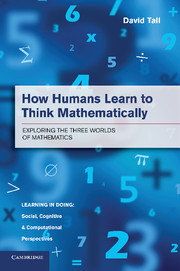Book contents
- Frontmatter
- Dedication
- Contents
- Series Foreword
- Journeys through three worlds of mathematics
- Preface
- Acknowledgements
- Illustration Credits
- I Prelude
- II School Mathematics and Its Consequences
- 2 The Foundations of Mathematical Thinking
- 3 Compression, Connection and Blending of Mathematical Ideas
- 4 Set-Befores, Met-Befores and Long-Term Learning
- 5 Mathematics and Emotion
- 6 The Three Worlds of Mathematics
- 7 Journeys through Embodiment and Symbolism
- 8 Problem Solving and Proof
- III Interlude
- IV University Mathematics and Beyond
- Appendix Where It All Came From
- References
- Index
2 - The Foundations of Mathematical Thinking
from II - School Mathematics and Its Consequences
Published online by Cambridge University Press: 05 June 2014
- Frontmatter
- Dedication
- Contents
- Series Foreword
- Journeys through three worlds of mathematics
- Preface
- Acknowledgements
- Illustration Credits
- I Prelude
- II School Mathematics and Its Consequences
- 2 The Foundations of Mathematical Thinking
- 3 Compression, Connection and Blending of Mathematical Ideas
- 4 Set-Befores, Met-Befores and Long-Term Learning
- 5 Mathematics and Emotion
- 6 The Three Worlds of Mathematics
- 7 Journeys through Embodiment and Symbolism
- 8 Problem Solving and Proof
- III Interlude
- IV University Mathematics and Beyond
- Appendix Where It All Came From
- References
- Index
Summary
This chapter begins the quest to seek the origins of mathematical thinking by asking the fundamental question:
How does a species like Homo sapiens learn to think mathematically?
In particular, how do young children build ideas about space and shape on the one hand and number on the other?
Mathematical thinking occurs within a biological brain that has evolved over the millennia to enable the human species to survive and prosper in the material world. The brain is not carefully designed like a computer. Francis Crick expressed this eloquently, saying:
Evolution is not a clean designer. … It builds, mainly in a series of smallish steps, on what was there before. It is opportunistic. If a new device works, in however odd a manner, evolution will try to promote it. This means that changes and improvements that can be added to the existing structures with relative ease are more likely to be selected, so the final design may not be a clean one, but rather a messy accumulation of interacting gadgets. Surprisingly, such a system often works better than a more straight-forward mechanism that is designed to do the job in a more direct manner.
Information
- Type
- Chapter
- Information
- How Humans Learn to Think MathematicallyExploring the Three Worlds of Mathematics, pp. 33 - 49Publisher: Cambridge University PressPrint publication year: 2013
